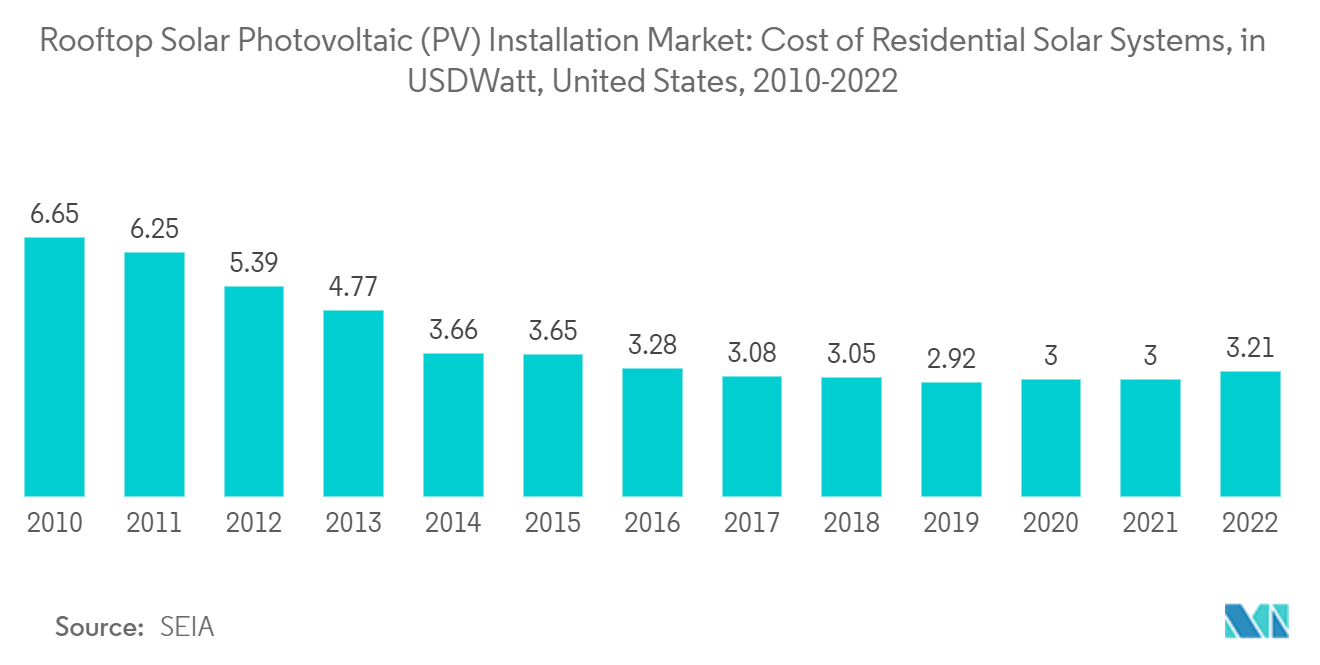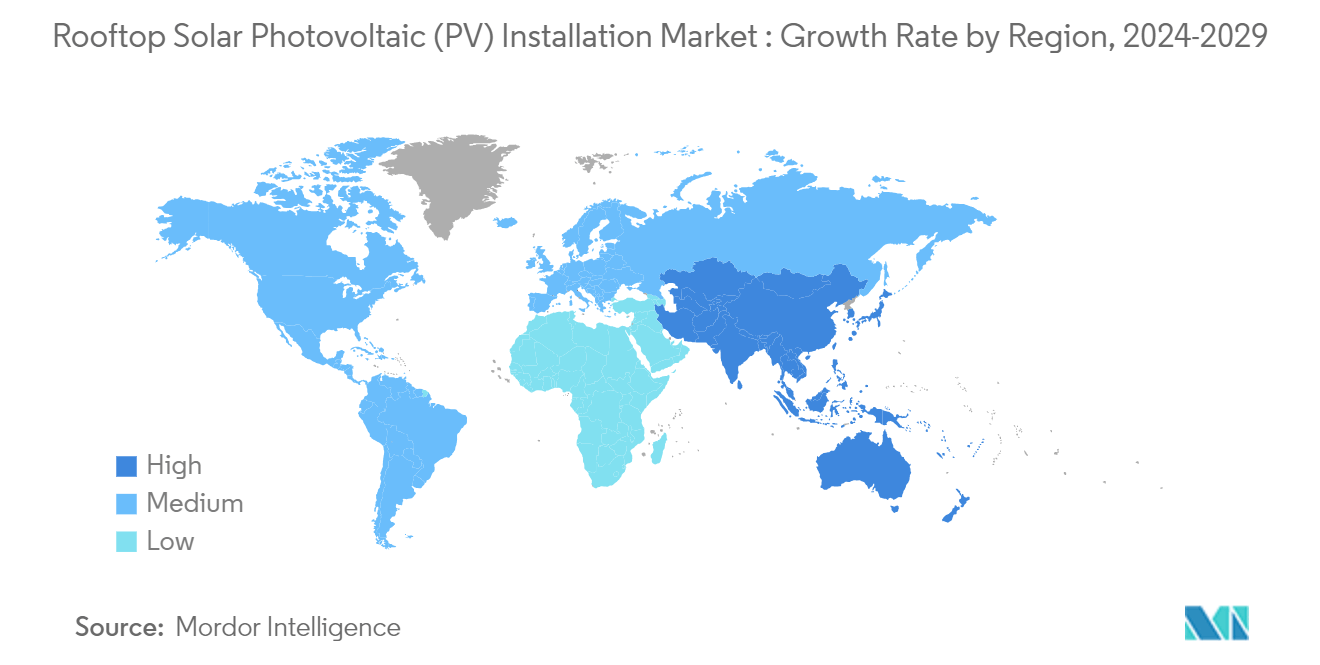Market Trends of Rooftop Solar Photovoltaic Installation Industry
Residential Rooftop Installation Expected to Dominate the Market
- The residential segment includes individual houses and residential building complexes. Residential rooftop-mounted systems are small compared to commercial and industrial rooftop systems. The residential rooftop solar PV system typically has a capacity range of up to 50 kW.
- The deployment of residential rooftop solar PV systems has increased significantly in recent years worldwide, owing to the declining costs and the government's supportive policies. Residential rooftop solar PV installations can be arranged in smaller configurations for mini-grids or personal use. There is a rise in demand for residential rooftop systems from various countries where residents need accessible, affordable, and reliable electricity options. In many countries, the electricity generated from solar PV is more economically attractive than buying electricity from the grid.
- For instance, in the past couple of years, the United States experienced rapid growth in residential rooftop solar installed capacity; according to the Solar Energy Industries Association, the residential rooftop solar PV installed capacity grew by around 40% between 2021 and 2022. In 2022, the annual installed capacity was 5.9 GW compared to 4.2 GW in 2021.
- Further, In 2022, the average cost of residential solar systems in the United States stood at USD 3.21 per watt. Although the price of residential solar has slightly increased in the last three years, it is still less than half the average cost registered in 2010. The decrease in the cost of residential solar systems has contributed to the significant increase in the solar capacity installed in United States households across the country.
- The European Union is actively promoting the domestic production of solar panels, exemplified by initiatives such as Enel Green Power's collaboration with the European Union to expand a solar panel Gigafactory located in Italy. Supported by European Union funding, Enel Green Power aims to increase its production capacity by a significant factor, specifically fifteen-fold, from the existing 200 MW to a substantial 3 GW. Anticipated to be operational by July 2024, this production facility represents a considerable investment totaling approximately USD 630 million, with an expected contribution from the European Union of around USD 124 million. This concerted effort is poised to drive down the cost of rooftop solar panels in the near term and to stimulate heightened demand for residential rooftop solar systems throughout Europe. The need for residential rooftops has increased in countries such as China, India, and Australia in the past couple of years due to government initiatives to promote solar energy projects in the residential sector and reduce installation costs.
- For instance, the Government of India initiated phase II of the Ministry of New and Renewable Energy's (MNRE) grid-connected rooftop solar program. Under this program, in April 2022, the Tamil Nandu Energy Development Agency issued a tender to install 12 MW of grid-connected residential rooftop solar systems in Tamil Nandu. Similarly, Telangana state's Renewable Energy Department Corporation invited bids to appoint suppliers to build 50 MW of grid-connected residential rooftop solar projects.
- Therefore, owing to the above points, the residential rooftop solar PV installation market is expected to dominate during the forecast period.

Asia-Pacific Expected to Dominate the Market
- Rapid urbanization, population growth, and industrialization across Asia-Pacific countries have fueled a substantial rise in electricity consumption. In response, governments and businesses are increasingly turning to rooftop solar PV installations as a viable means to augment energy supply while addressing environmental concerns.
- Moreover, the Asia-Pacific region offers an abundance of sunlight, making it exceptionally conducive to solar energy generation. The favorable climatic conditions and technological advancements in solar panel efficiency ensure optimal energy yield from rooftop installations. This natural advantage bolsters the region's attractiveness and viability of solar PV installations.
- China is home to nearly all the largest solar photovoltaic (PV) manufacturing companies and facilities globally, with almost 70% of the global solar PV manufacturing capacity in China. These companies also dominate other businesses, such as polysilicon, ingot, and wafer-making, which are integral to the solar panel supply chain. This extraordinary control of the global solar PV supply chain puts Chinese manufacturers at a more significant advantage when compared to solar equipment manufacturers from other countries.
- Furthermore, proactive government policies and incentives play a pivotal role in propelling Asia-Pacific to the forefront of the rooftop solar PV market. Governments across the region have implemented robust support mechanisms, including feed-in tariffs, tax credits, and regulatory frameworks that encourage the adoption of rooftop solar PV systems. These incentives reduce the financial burden on consumers and businesses, stimulating rapid market growth.
- In June 2022, the Australian government released new rooftop solar PV regulations. The government committed USD 19.2 million in the 2021-22 budget to reform the SRES (Small-scale Renewable Energy Scheme). The amendment regulations aim to protect consumers better and improve integrity in the rooftop solar sector. The amendments are as follows:
- Streamline reporting requirements for installers, solar retailers, and manufacturers. Allow the Regulator to take a more direct role in setting the conditions for solar PV components eligible for small-scale technology certificates. Such mandates are expected to see a massive rise in rooftop solar PV adoption during the forecast period.
- Therefore, owing to the above points, Asia-Pacific is expected to dominate the rooftop solar PV installation market during the forecast period.


